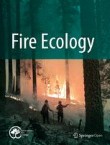Fire Ecology is the official journal of the Association for Fire Ecology.
Restoration applications of resource objective wildfires in western US forests: a status of knowledge review
Frequent-fire forests of the western United States have undergone remarkable changes in structure, composition, and function due to historical exclusion of naturally occurring fire. Mechanized tree thinning to...
